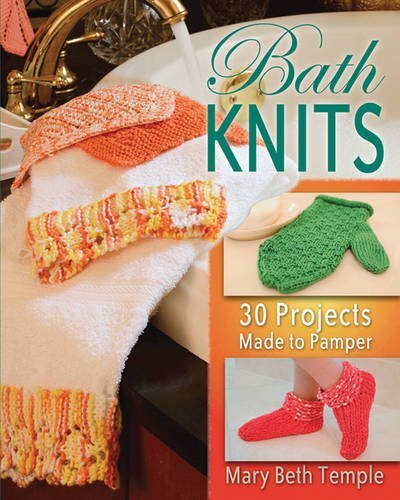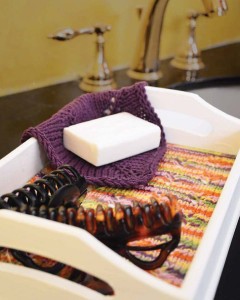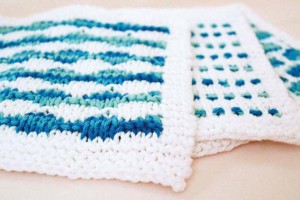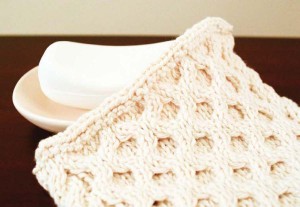
Bath Knits: 30 Projects Made to Pamper hit the shelves on February 1, featuring the best of Mary Beth Temple’s knitting designs for a spa-style bathroom. Teacher, author, and designer Mary Beth uses her extensive experience to create 30 original patterns, including classic washcloths and hand towels, decorative wall hangings and bath mats, and a
Bath Knits: 30 Projects Made to Pamper hit the shelves on February 1, featuring the best of Mary Beth Temple’s knitting designs for a spa-style bathroom. Teacher, author, and designer Mary Beth uses her extensive experience to create 30 original patterns, including classic washcloths and hand towels, decorative wall hangings and bath mats, and a luxurious robe, pair of slippers, and pedicure socks. Check out our Knit Lit selections for this issue to find out more about Bath Knits.
In addition to her frequent contributions to I Like Knitting and I Like Crochet, Mary Beth has previously published numerous books, including Fabulous Fat Quarter Aprons, Hooked for Life: Adventures of a Crochet Zealot, and Arm Knitting. In an email interview, Mary Beth gave I Like Knitting the scoop on Bath Knits, her design process, and her perspective on the intersection of knitting and technology—plus she gives us a hint of what we can expect from her next.


Q: What inspired you to design specifically for the bathroom/spa?
Mary Beth: I am all about skill building for crafters of all stripes. A lot of knitters begin to expand their personal list of go-to techniques by practicing on washcloths or dishcloths. But there are already tons of simple washcloth patterns out there. So I got the idea of using the washcloth patterns as a base for the book, and then branching out to other projects that are still relatively simple to make, but would provide something new for a knitter to make.
That, plus I am a home décor junkie. I would make home décor items all day every day if I could get away with it!
Q: In total, about how long does it take for a project like this to go from its beginning stages to reality?
Mary Beth: That depends on so many variables! I would say Bath Knits would have taken about 14 months from the day I signed the contract to the publication date, but in this particular case there was a corporate change at the publisher that caused the publication date to be postponed even though the book was finished. No harm done though – since Bath Knits uses a lot of workhorse yarns, especially in cotton and linen, there haven’t been any problems with discontinued yarns or outdated styles, thank goodness.
Q: What’s your favorite pattern in Bath Knits?
Mary Beth: That’s a tough one! I had great fun designing the bathrobe with its matching slippers and headband of course. My favorite utility pattern is the green textured bath mitt – I like how the stitch pattern and yarn contribute to its usefulness but it is also very pretty and was interesting to make.
Q: What is your creative process like—for instance, what sparks your design ideas and color schemes?
Mary Beth: I don’t know that it’s any one thing all the time. But one of the things I like about the way Bath Knits is set up is that it’s organized by style of room décor rather than type of item. Because home décor items may be fun to knit but they’re not useful if they don’t fit your individual aesthetic, the sections are divided into distinct color blocks – naturals, blues/greens, floral colors, and modern/hot pink. Of course, you can change the colors of any of the projects to suit your own tastes, but the colors here were heavily influenced by trying to put together a cohesive room, rather than a stack of pretty items.
Q: You’ve been published in magazines and written your own books, so you have quite a bit of experience when it comes to writing and designing for publication. Was there anything that made this Bath Knits project unique or stand out for you?
Mary Beth: Absolutely! This was the most control I have ever had over organization of the final project – again, I really wanted the room by room layout and was thrilled to be able to do it my way – and this was the first time I was solely responsible for managing the photo shoot. In the past I have shipped the projects off to the publisher/photographer and sent some notes and hoped our collective visions matched. This book, for good or ill, is perhaps the truest representation of my original vision that I have been able to have in a book.
Q: Who taught you to knit and crochet?
Mary Beth: My sister Trish taught me to knit at a very young age – I think I’d been ill and it was something I could sit quietly and do. My mother taught me to crochet – which was interesting after I’d been crocheting for many years and realised I held my hook and yarn oddly because she was left-handed and I am not!
Q: I read on your website that before turning to designing full time, you were a New York City costumer. Can you tell me more about that, and also how it has influenced your fiber art designing since then?
Mary Beth: So many stories! But after many years touring the world doing wardrobe for various dance companies I joined the wardrobe union in NYC. I began my union career working backstage on musicals, assisting with quick changes and maintaining the clothes, then branched into cable and network television shows, and even worked on a couple of feature films.
I think the biggest effect that has had on my knitwear designs is twofold – I have a deep appreciation for fit and how my pieces are worn, and I care about making things last. Putting clothes on dancers gives one a deep appreciation of how the human body moves, and the absolutely certainty that if the clothes don’t move with the person they are not going to be comfortable! And if I am going to put the time and effort and expense into creating something for myself or my home, I want to know it will last – items that will lose their appeal after use or laundering don’t appeal to me at all. While I love the process of knitting and crocheting, I want to enjoy the results as well.
Q: What does a day in the life of Mary Beth Temple generally look like?
Mary Beth: General chaos! So many people seem to think designers get to knit or crochet all day but that very rarely happens. I could be traveling to teach or to a trade show, making videos for myself or a client, answering emails from customers, swatching new designs, planning new books or classes or other projects, and the boring stuff like writing invoices and doing collections! I love what I do and treasure the flexibility in my life that it has brought me but this is not a career for those who prefer a strict routine!
Q: What is the key to being an effective knitting teacher, both in your classes and through the instructions in your books?
Mary Beth: That’s an interesting question – and I think it’s different in both cases.
In print it’s a hard line to toe – you want to be absolutely sure that the knitter has every piece of information they need to successfully complete the project, without annoying the more experienced knitters who’d prefer you get to the point without too much explanation of the basics, while at the same time not scaring off folks who prefer every single step be written out for them. As more and more publishers include stitch diagrams I think that’s gotten easier – people can use the method to learn that pattern that suits them best.
In live teaching I think it’s being able to react in the moment. You can do all the preparation in the world but it’s the interaction between the students with each other and the students with the teacher that make people take live classes instead of relying solely on books or videos. Being able to punt, as it were, when new questions are asked or new things come up is a lifesaver.
In both cases though, it’s being encouraging. While it’s good to learn new things, and if you want your project to look like it does in the photo you have to put the effort into it to do it the way the designer tells you, at the end of the day no one is going to die from a knitting mistake. Some people just need you to tell them it’s ok to learn the way you learn, to try until you get it, and to be happy with their new skills no matter where on the spectrum they may fall.
Q: You have published eBooks, held podcasts, and run your own website as part of your knitting and crochet business. How do you think the internet has influenced the way people learn and practice these traditional crafts?
Mary Beth: I think there’s another book there in the answer to this! One of the things that is said about the internet is that it brought many communities together, whether their common interest was a craft, a type of book, or something less savory! One of the cool things about the knitting community is how it has embraced the online component. There will always be those who prefer to learn and socialize with their knitting in person, but for those who chose otherwise – or who don’t have access to vibrant in-person communities – the internet has been an incredible gift.
As for tradition – every stitch we make honors the traditions of those who came before. The communities may have changed but the knit and purl stitches do not.
Q: Do you have other projects in the works—and most importantly, can you give us any hints about what to expect?
Mary Beth: Goodness I am just recovering from this one! I am finishing up a book on jewelry made with fabric which I am having a great time with, and pondering what my next yarn-craft book might be. I am trying to focus more on videos because while I have made a bunch, they tend to get posted in fits and starts, not on any type of regular schedule so I am trying to be better about that. And I am always designing something, somewhere!
The knitting community is sure to see more of Mary Beth Temple, and her final sentiment is one to which all knitters can relate: that feeling of always knitting or designing “something, somewhere” and honoring the rich tradition of a beloved craft. Plus, if you can’t wait to get your hands on the patterns from Bath Knits, you are in luck—we are giving away a free copy on our blog.



